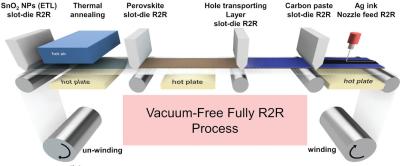Perovskite-Info weekly newsletter
Published: Tue, 04/11/23
The Perovskite-Info newsletter (April 11, 2023)
Cannot read this? View it online here
Researchers create a material for processing and storing quantum computing information
Researchers from North Carolina State University, University of North Carolina at Chapel Hill, Massachusetts Institute of Technology (MIT), National Renewable Energy Laboratory, Duke University, Wayne State University and The Hong Kong University of Science and Technology have created a mixed magnon state in an organic hybrid perovskite material by utilizing the Dzyaloshinskii-Moriya-Interaction (DMI).
The resulting material has potential for processing and storing quantum computing information. The work also expands the number of potential materials that can be used to create hybrid magnonic systems.
HZB sets new tandem solar cell world record, using MBRAUN systems
This is a sponsored post by MBRAUN
For years, the Helmholtz-Zentrum in Berlin has been researching the development of highly efficient perovskite tandem solar cells with great success. The HySprint Innovation Lab was founded specifically for this purpose, which cooperates internationally with other research groups as well as with industrial partners.
Many process steps are necessary to produce these highly efficient perovskite cells, which can all be realized together in the HySprint laboratory. A good research environment and high-quality equipment allow researchers to work optimally on their projects. The results at HZB are impressive. In recent years, the researchers have made significant progress in the field of perovskite tandem solar cells and achieved independently certified world record of tandem solar cells.
Researchers examine room-temperature superfluorescence in hybrid perovskites
Researchers from North Carolina State University and CNRS have reported room-temperature superfluorescence in hybrid perovskite thin films.
Their work shows that in this material platform, there exists an extremely strong immunity to electronic dephasing due to thermal processes. To explain this observation, the team proposed that the formation of large polarons in hybrid perovskites provides a quantum analogue of vibration isolation to electronic excitation and protects it against dephasing even at room temperature.
Researchers report triple junction perovskite solar cell with 24.3% efficiency
Researchers from the University of Toronto in Canada, Northwestern University, The University of Toledo and University of North Carolina at Chapel Hill in the United States, King Abdullah University of Science and Technology (KAUST) in Saudi Arabia, Yunnan University in China, Ecole Polytechnique Fedérale de Lausanne (EPFL) in Switzerland and University of Warwick in the UK have developed a triple-junction perovskite solar cell with a record efficiency of 24.3% with an open-circuity voltage of 3.21 V.
The NREL has certified the cell’s quasi-steady-state efficiency as 23.3%, which the team stated is the first reported certified efficiency for perovskite-based triple-junction solar cells. They added that triple-junction perovskite solar cells have so far demonstrated a maximum efficiency of around 20%.
Researchers develop printable perovskite diodes for broad-spectrum multienergy X-ray detection
Researchers from Monash University, University of Illinois at Chicago, University of Cambridge and CSIRO Manufacturing have used solution-processed, printable diodes based on perovskite thin films to make a printable, multi-energy X-Ray detector with significantly enhanced flexibility and sensitivity.
Schematic depiction of the fabrication process of an X-ray diode on flexible substrates using a custom-made slot die set up on a commercial R2R coater.
Silicon and selenium X-ray detectors are the most common for multi-energy X-ray detection. however, these tend to present poor energy discrimination across the broad X-ray spectrum and exhibit limited spatial resolution due to the high thicknesses required for radiation attenuation. In this recent work, the new technology for the X-ray detector is able to overcome these challenges.
Metalgrass LTD
9 Har Tsin St.
Kfar Sava Hasharon 4430809
ISRAEL
Unsubscribe | Change Subscriber Options






